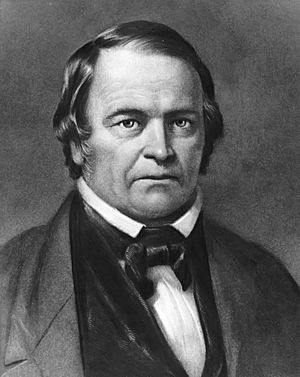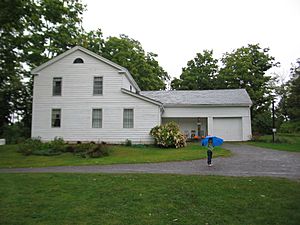William Miller (preacher) facts for kids
Quick facts for kids
William Miller
|
|
|---|---|
 |
|
| Born | February 15, 1782 |
| Died | December 20, 1849 (aged 67) Low Hampton, New York, U.S.
|
| Occupation | Farmer Military officer Baptist minister Author Leader of the Millerite movement |
| Spouse(s) | Lucy Smith |
| Children | 5 |
William Miller (February 15, 1782 – December 20, 1849) was an American Baptist preacher. He started a religious movement in the mid-1800s called Millerism. He believed that Jesus would return to Earth in the 1840s.
When this did not happen, his followers formed new groups. These included the Advent Christians and the Seventh-day Adventists. These groups are part of a larger movement called Adventism.
Contents
Who Was William Miller?
William Miller's Early Life
William Miller was born on February 15, 1782, in Pittsfield, Massachusetts. His father, Captain William Miller, fought in the American Revolution. When William was four, his family moved to Low Hampton, New York.
He was taught at home by his mother until he was nine. Then he went to a new school in East Poultney. William loved to read many books. He could use the private libraries of important people nearby.
In 1803, Miller married Lucy Smith. They moved to her hometown of Poultney, Vermont. There, he became a farmer. He was also elected to several local jobs, like Constable and Deputy Sheriff. He also served as a Justice of the Peace.
Miller joined the Vermont militia and became a lieutenant in 1810. He was doing well, owning a house, land, and horses.
William Miller's Beliefs
When he first moved to Poultney, Miller stopped following his Baptist faith. He became a Deist. Deists believe in God but think God does not get involved in daily human life. Miller read books by famous Deist writers like Voltaire and Thomas Paine.
William Miller's Military Service
When the War of 1812 began, Miller gathered local men to fight. He joined the U.S. Army as a lieutenant. He mostly worked to find new soldiers. In 1814, he became a captain.
Miller fought in the Battle of Plattsburgh. American forces, though outnumbered, won this battle. Miller was very close to an explosion that wounded three men and killed one. But he was not hurt.
This battle made Miller rethink his Deist beliefs. He felt that God must have helped the Americans win. He thought it was too amazing to be just luck. This experience made him believe in a God who was more involved in the world.
William Miller's Religious Journey
After the war, Miller left the army in 1815. He moved back to Low Hampton with his family. He bought a farm there, which is now a historic site.
Miller started thinking a lot about death and what happens after life. His experiences in the war and the deaths of his father and sister made him wonder. He felt there were only two choices after death: either you disappear completely, or you are held responsible for your life. He was not comfortable with either idea.
Returning to Faith
Miller slowly returned to his Baptist faith. At first, he still believed in Deism but went to his local Baptist church. He started helping out by reading sermons when the minister was away. One Sunday, while reading about parents' duties, he became very emotional. This moment marked his full return to faith.
His Deist friends challenged him to explain his new beliefs. Miller decided to study the Bible very carefully. He told a friend he would find answers or remain a Deist. He started from Genesis 1:1 and studied each verse until he understood it.
Understanding Bible Prophecy
Through his study, Miller became convinced of two things. First, he believed that the idea of postmillennialism (that the world would get better before Jesus returned) was not in the Bible. Second, he believed the Bible showed when Jesus would return.

Miller focused on a verse from the Bible book of Daniel (Daniel 8:14). It says: "Unto two thousand and three hundred days; then shall the sanctuary be cleansed." Miller believed "cleansing of the sanctuary" meant the Earth would be purified by fire when Jesus returned.
He used a special way of understanding Bible prophecy called the "day-year principle." This means that in prophecy, one day can mean one year. So, 2,300 days would mean 2,300 years.
Miller believed the 2,300-year period started in 457 BC. This was when a king named Artaxerxes I of Persia gave a command to rebuild Jerusalem. If you add 2,300 years to 457 BC, it leads to the year 1843. Miller concluded that Jesus would return around 1843.
Sharing His Message
Miller was sure of his findings by 1818. But he kept studying until 1823 to be certain. In 1822, he wrote down his beliefs. He stated that Jesus's second coming was "near, even at the door, even within twenty-one years, – on or before 1843."
He did not start preaching publicly until August 1831. In 1832, he sent articles to a Baptist newspaper. People became very interested and sent him many questions. In 1834, he published a 64-page book explaining his ideas.
What Was Millerism?
From 1840 on, Miller's movement grew from a small local group to a national one. A key person in this growth was Joshua Vaughan Himes. He was a pastor and a skilled publisher.
Himes started a newspaper called Signs of the Times in 1840. This newspaper helped spread Miller's ideas to many people.
Miller never set an exact date for Jesus's return. But his followers urged him to narrow it down. He said it would be sometime between March 21, 1843, and March 21, 1844.
When March 21, 1844, passed without Jesus's return, people were disappointed. They then looked at a new date, April 18, 1844, based on a different calendar. This date also passed. Miller admitted his mistake but still believed Jesus's return was close.
In August 1844, a preacher named Samuel S. Snow suggested a new date. He said Jesus would return on October 22, 1844. This date was based on the "tenth day of the seventh month" of the Jewish calendar, which was Yom Kippur.
The Great Disappointment
When Jesus did not return on October 22, 1844, it was a huge disappointment for Miller's followers. This event became known as the Millerites' Great Disappointment.
One follower, Hiram Edson, wrote about how sad they were. He said, "Our fondest hopes and expectations were blasted... We wept, and wept, till the day dawn."
| What Happened on October 22, 1844? | What They Thought About the Prophecy | Their Reaction | Number of Followers | Current Groups |
|---|---|---|---|---|
| No Second Advent | 1844 date was wrong prophecy was wrong |
Gave up their beliefs | Tens of thousands | Most left Christianity Some went back to their old churches |
| No Second Advent | 1844 date was wrong prophecy was right |
Believed Jesus was still coming soon Some set new dates |
Many hundreds | Advent Christian Church, Jehovah's Witnesses |
| Second Advent happened – but in a spiritual way | 1844 date was right prophecy was right |
Believed in a short-lived "holy flesh" movement | Hundreds | Joined Shakers |
| Date was not about the Second Advent | 1844 date was right Their understanding was wrong |
Believed "cleansing of Sanctuary" meant a judgment before Jesus returns Second Advent still coming |
Dozens | Seventh-day Adventist Church |
After the Great Disappointment, most Millerites stopped believing. But some continued to believe and tried to understand what happened. Miller himself still believed Jesus would return soon. He thought there might have been a small mistake in the Bible timeline.
It is estimated that Miller had between 50,000 and 500,000 followers. His legacy lives on in groups like the Advent Christian Church (with about 61,000 members) and the Seventh-day Adventist Church (with over 19 million members). Both these churches came directly from the Millerite movement.
William Miller died on December 20, 1849. He still believed that Jesus's return was very close. He is buried near his home in Low Hampton, New York. His home is now a National Historic Landmark and a museum.
Images for kids
See Also
 In Spanish: William Miller (predicador) para niños
In Spanish: William Miller (predicador) para niños







